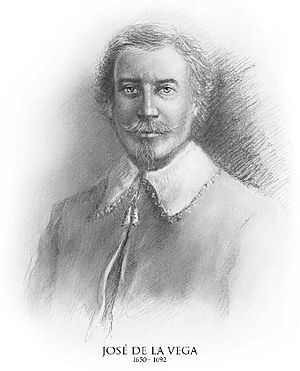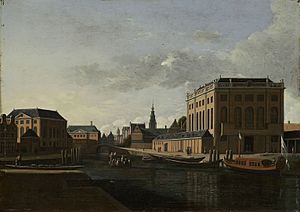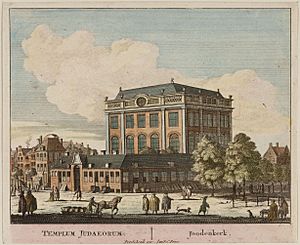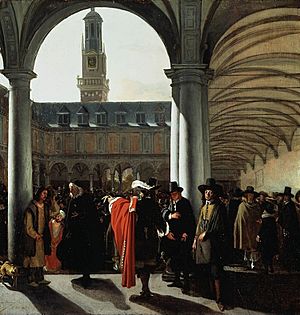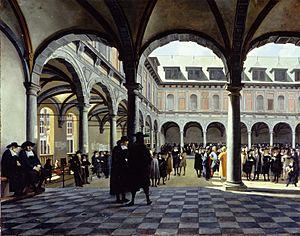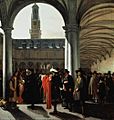Joseph de la Vega facts for kids
Joseph de la Vega (born around 1650 in an unknown place, died November 13, 1692, in Amsterdam) was a smart Jewish merchant, money expert, and writer. He lived in Amsterdam and was famous for his important book, Confusion of Confusions. This book was the very first detailed study about the Amsterdam Stock Exchange and the people who traded there. It described many ways people bought and sold shares, like betting on future prices or borrowing money to buy more shares. His book helped create the ideas behind how we study markets and human financial decisions today.
Contents
Joseph de la Vega's Life Story
Joseph Penso Felix was born around 1650. His family were Spanish and Portuguese Jews. His father, Isaac Penso Félix, was a merchant who had been forced to hide his Jewish faith in Spain. After escaping, he openly practiced Judaism in the Netherlands. The family settled in Amsterdam around 1655. Joseph had several brothers and sisters. Some of his brothers became merchants, and one even sold diamonds and traded in slaves.
Joseph was taught by important teachers in the Jewish community. In 1673, he finished his first play, "Asire ha-Tiḳwah" (meaning "The prisoner of hope"). This play was about how willpower can overcome strong feelings. Joseph started his business life in Amsterdam in 1679. He also held important positions in local groups, like being president of the Academia de los Sitibundos and secretary of the Academia de los Floridos. These were groups where educated people met to discuss ideas.
In 1688, Joseph de la Vega faced a big challenge when two major Dutch trading companies, the Dutch East India Company and Dutch West India Company, had financial problems. This caused him to lose a lot of money. At the same time, a big event called the Glorious Revolution in England caused a financial crisis in the Netherlands. Many Dutch money experts went to England, taking their financial knowledge with them. This helped London become a major center for trading. Joseph de la Vega was buried in a Jewish cemetery called Beth Haim of Ouderkerk aan de Amstel.
Confusion of Confusions (1688)
Joseph de la Vega wrote his famous book, Confusión de Confusiones, in Spanish. It was printed in Amsterdam. The book didn't just describe how stock trading worked. Instead, it told the story of how people gambled on stocks and old coins called ducatons. It also explained the clever ways people used money tools. Joseph wrote the book as a conversation between different people involved in the market. This helped readers understand their different viewpoints and the tricky parts of trading. The book showed how people often follow the crowd, are too confident, or regret their decisions.
Joseph also shared four main rules for trading that are still useful today:
- The first rule is: Never tell anyone to buy or sell shares. Since guessing correctly is like magic, advice can't be too proud.
- The second rule is: Accept both your wins and your losses. It's best to take what you get when you get it, and not expect good luck to last forever.
- The third rule is: Money made in the stock market is like a goblin's treasure. One moment it's valuable jewels, the next it's just coal. Sometimes it's diamonds, other times it's just pebbles.
- The fourth rule is: Anyone who wants to get rich from this game needs both money and patience.
Joseph de la Vega's Impact
Joseph de la Vega, who used his mother's last name, wrote many letters to important leaders. His book Confusión de Confusiones was not well known for a long time. But in 1892, a German economist named Richard Ehrenberg wrote an important essay about it. Some experts say Joseph focused too much on tricks and schemes in his book. They believe it was written more for entertainment for educated members of his community than as a guide.
Since the year 2000, the Federation of European Securities Exchanges has given out the annual De La Vega Prize. This award goes to young European researchers who do excellent work studying the stock markets in Europe.
Other Writings
Here are some other works Joseph de la Vega wrote:
- Discurso académico moral (Amsterdam, 1683)
- Triunfos del águila y eclipses de la luna (Amsterdam, 1683)
- La Rosa, Panegírico Sacro (Amsterdam, 1683)
- Rumbos peligrosos (Antwerp, 1684)
- Discursos académicos, morales, retóricos, y sagrados (Antwerp, 1685)
- Retrato de la Prudencia, y simulacro del Valor (Amsterdam, 1690)
Images for kids
Source
- Jewish Encyclopedia The article on Penso, Joseph was written by Isidore Singer and Meyer Kayserling
- Valuation Of Equity Securities: History, Theory And Application by Geoffrey Poitras
See also
 In Spanish: José Penso de la Vega para niños
In Spanish: José Penso de la Vega para niños


